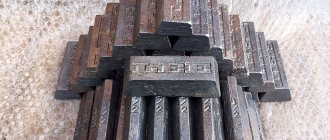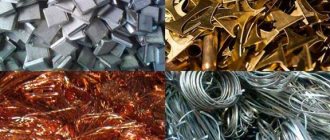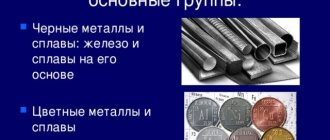Thermal conductivity of non-ferrous metals and technical alloys
The table shows the thermal conductivity values of metals (non-ferrous), as well as the chemical composition of metals and technical alloys in the temperature range from 0 to 600°C.
Non-ferrous metals and alloys: nickel Ni, monel, nichrome; nickel alloys (according to GOST 492-58): cupronickel NM81, NM70, constantan NMMts 58.5-1.54, copel NM 56.5, monel NMZhMts and K-monel, alumel, chromel, manganin NMMts 85-12, invar; magnesium alloys (according to GOST 2856-68), electron, platinum-rhodium; soft solders (according to GOST 1499-70): pure tin, lead, POS-90, POS-40, POS-30, Rose alloy, Wood alloy.
The table shows that magnesium alloys and nickel have high thermal conductivity (at room temperature). Low thermal conductivity is characteristic of nichrome, invar and Wood's alloy.
What does thermal conductivity depend on?
Studying the ability of heat transfer by metal products, it was revealed that thermal conductivity depends on:
- type of metal;
- chemical composition;
- porosity;
- sizes.
Metals have different crystal lattice structures, and this can change the thermal conductivity of the material. For example, in steel and aluminum, the structural features of microparticles affect differently the rate of transfer of thermal energy through them.
The thermal conductivity coefficient can have different values for the same metal when the exposure temperature changes. This is due to the fact that different metals have different melting degrees, which means that under other environmental parameters, the properties of the materials will also differ, and this will affect thermal conductivity.
Thermal conductivity coefficients of aluminum, copper and nickel alloys
The thermal conductivity of metals, aluminum, copper and nickel alloys in the table is given in the temperature range from 0 to 600°C in the dimension W/(m deg). Metals and alloys: aluminum, aluminum alloys, duralumin, brass, copper, monel, nickel silver, nichrome, ferrous nichrome, mild steel. Aluminum alloys have greater thermal conductivity than brass and nickel alloys.
Which metal heats up quickly?
If the thermal conductivity of silver is conventionally taken as 100, then the thermal conductivity of copper will be 90, aluminum 27, iron 15, lead 12, mercury 2, and the thermal conductivity of wood is only 0.05. The greater the thermal conductivity of the metal, the faster and more evenly it heats up.
Interesting materials:
How much energy does an electric oven use? How many episodes are there in Life Is Strange 2? How many steps does it take to solve a problem on a computer? How many floors is the tallest skyscraper? How many euros are in circulation in the world? How many phases are there in electricity? How many films have been made about Percy Jackson? How many infinitive forms does a Latin verb have? How many photos can you upload to Instagram in one post? How many photos can you upload to VK per day?
Thermal conductivity coefficients of alloys
The table shows the thermal conductivity values of alloys in the temperature range from 20 to 200ºС. Alloys: aluminum bronze, bronze, phosphor bronze, invar, constantan, manganin, magnesium alloys, copper alloys, Rose alloy, Wood's alloy, nickel alloys, nickel silver, platinum-iridium, electron alloy, platinum-rhodium.
Thermal conductivity of copper - how does it affect the properties of copper?
In physics, thermal conductivity is understood as the movement of energy in an object from more heated small particles to less heated ones. Thanks to this process, the temperature of the object in question as a whole is equalized.
The magnitude of the ability to conduct heat is characterized by the thermal conductivity coefficient.
This parameter is equal to the amount of heat that a material 1 meter thick passes through a surface area of 1 m2 for one second at a unit temperature difference.
Copper has a thermal conductivity coefficient of 394 W/(m*K) at temperatures from 20 to 100 °C. Only silver can compete with it. And for steel and iron this figure is 9 and 6 times lower, respectively (see table).
It is worth noting that the thermal conductivity of products made from copper largely depends on impurities (however, this also applies to other metals).
For example, the rate of heat conduction decreases if substances such as:
If you add zinc to copper, you get brass, which has a much lower thermal conductivity coefficient. At the same time, adding other substances to copper can significantly reduce the cost of finished products and give them characteristics such as strength and wear resistance. For example, brass is characterized by higher technological, mechanical and anti-friction properties.
Since high thermal conductivity is characterized by rapid distribution of heating energy throughout the entire object, copper is widely used in heat exchange systems. At the moment, radiators and tubes for refrigerators, vacuum units and cars are made from it for rapid heat removal. Copper elements are also used in heating installations, but for heating.
Copper heating radiator
In order to maintain the thermal conductivity of the metal at a high level (and therefore make the operation of copper devices as efficient as possible), forced airflow by fans is used in all heat exchange systems. This decision is due to the fact that as the temperature of the environment increases, the thermal conductivity of any material decreases significantly, because heat transfer slows down.
The concept of thermal resistance and thermal conductivity coefficient
If thermal conductivity characterizes the ability of metals to transfer the temperature of bodies from one surface to another, then thermal resistance shows an inverse relationship, i.e. the ability of metals to prevent such transfer, in other words, to resist. Air has high thermal resistance. It is he who, most of all, prevents the transfer of heat between bodies.
The quantitative characteristic of the change in temperature of a unit area per unit of time by one degree (K) is called the thermal conductivity coefficient. The international system of units usually measures this parameter in W/m*deg. This characteristic is very important when choosing metal products that must transfer heat from one body to another.
| Metal | Thermal conductivity coefficient of metals at temperature, °C | ||||
| — 100 | 100 | 300 | 700 | ||
| Aluminum | 2,45 | 2,38 | 2,30 | 2,26 | 0,9 |
| Beryllium | 4,1 | 2,3 | 1,7 | 1,25 | 0,9 |
| Vanadium | — | — | 0,31 | 0,34 | — |
| Bismuth | 0,11 | 0,08 | 0,07 | 0,11 | 0,15 |
| Tungsten | 2,05 | 1,90 | 1,65 | 1,45 | 1,2 |
| Hafnium | — | — | 0,22 | 0,21 | — |
| Iron | 0,94 | 0,76 | 0,69 | 0,55 | 0,34 |
| Gold | 3,3 | 3,1 | 3,1 | — | — |
| Indium | — | 0,25 | — | — | — |
| Iridium | 1,51 | 1,48 | 1,43 | — | — |
| Cadmium | 0,96 | 0,92 | 0,90 | 0,95 | 0,44 (400°) |
| Potassium | — | 0,99 | — | 0,42 | 0,34 |
| Calcium | — | 0,98 | — | — | — |
| Cobalt | — | 0,69 | — | — | — |
| Lithium | — | 0,71 | 0,73 | — | — |
| Magnesium | 1,6 | 1,5 | 1,5 | 1,45 | — |
| Copper | 4,05 | 3,85 | 3,82 | 3,76 | 3,50 |
| Molybdenum | 1,4 | 1,43 | — | — | 1,04 (1000°) |
| Sodium | 1,35 | 1,35 | 0,85 | 0,76 | 0,60 |
| Nickel | 0,97 | 0,91 | 0,83 | 0,64 | 0,66 |
| Niobium | 0,49 | 0,49 | 0,51 | 0,56 | — |
| Tin | 0,74 | 0,64 | 0,60 | 0,33 | — |
| Palladium | 0,69 | 0,67 | 0,74 | — | — |
| Platinum | 0,68 | 0,69 | 0,72 | 0,76 | 0,84 |
| Rhenium | — | 0,71 | — | — | — |
| Rhodium | 1,54 | 1,52 | 1,47 | — | — |
| Mercury | 0,33 | 0,09 | 0.1 | 0,115 | — |
| Lead | 0,37 | 0,35 | 0,335 | 0,315 | 0,19 |
| Silver | 4,22 | 4,18 | 4,17 | 3,62 | — |
| Antimony | 0,23 | 0,18 | 0,17 | 0,17 | 0,21 |
| Thallium | 0,41 | 0,43 | 0,49 | 0,25 (400 0) | |
| Tantalum | 0,54 | 0,54 | — | — | — |
| Titanium | — | — | 0,16 | 0,15 | — |
| Thorium | — | 0,41 | 0,39 | 0,40 | 0,45 |
| Uranus | — | 0,24 | 0,26 | 0,31 | 0,40 |
| Chromium | — | 0,86 | 0,85 | 0,80 | 0,63 |
| Zinc | 1,14 | 1,13 | 1,09 | 1,00 | 0,56 |
| Zirconium | — | 0,21 | 0,20 | 0,19 | — |
: Steel nitriding: process technology, equipment
Aluminum and copper - which is better?
Aluminum has one disadvantage compared to copper: its thermal conductivity is 1.5 times less, namely 201–235 W/(m*K). However, compared to other metals, these are quite high values. Aluminum, like copper, has high anti-corrosion properties. In addition, it has advantages such as:
- low density (specific gravity 3 times less than that of copper);
- low cost (3.5 times less than copper).
Aluminum heating radiator
Thanks to simple calculations, it turns out that an aluminum part can be almost 10 times cheaper than a copper part, because it weighs much less and is made of cheaper material.
This fact, along with high thermal conductivity, allows the use of aluminum as a material for cookware and food foil for ovens.
The main disadvantage of aluminum is that it is softer, so it can only be used in alloys (for example, duralumin).
For effective heat transfer, the rate of heat transfer to the environment plays an important role, and this is actively facilitated by the cooling of radiators. As a result, the lower thermal conductivity of aluminum (relative to copper) is leveled out, and the weight and cost of the equipment are reduced. These important advantages allow aluminum to gradually replace copper from use in air conditioning systems.
Use of copper in electronics
In some industries, for example, in the radio industry and electronics, copper is essential.
The fact is that this metal is very ductile in nature: it can be drawn into extremely thin wires (0.005 mm), and also can be used to create other specific conductive elements for electronic devices.
And high thermal conductivity allows copper to extremely effectively remove the heat that inevitably arises during the operation of electrical appliances, which is very important for modern high-precision, but at the same time compact equipment.
The use of copper is relevant in cases where it is necessary to deposit a certain shape on a steel part. In this case, a copper template is used, which is not connected to the element being welded. Using aluminum for these purposes is impossible, as it will melt or burn through. It is also worth mentioning that copper can act as a cathode when welding with a carbon arc.
What is thermal conductivity and why is it needed?
The process of transferring the energy of atoms and molecules from hot objects to products with a cold temperature is carried out during the chaotic movement of moving particles. Such heat exchange depends on the state of aggregation of the metal through which the transmission passes.
Depending on the chemical composition of the material, thermal conductivity will have different characteristics.
This process is called thermal conductivity, it consists in the transfer of kinetic energy by atoms and molecules, which determines the heating of a metal product during the interaction of these particles, or is transferred from a warmer part to one that is less heated.
The ability to transfer or store thermal energy makes it possible to use the properties of metals to achieve the necessary technical goals in the operation of various components and assemblies of equipment used in the national economy.
An example of such an application would be a soldering iron that heats up in the middle part and transfers heat to the edge of the working rod, which is used to solder the necessary elements.
Knowing the properties of thermal conductivity, metals are used in all industries, using the required parameter for its intended purpose.
What does thermal conductivity depend on?
Studying the ability of heat transfer by metal products, it was revealed that thermal conductivity depends on:
- type of metal;
- chemical composition;
- porosity;
- sizes.
Metals have different crystal lattice structures, and this can change the thermal conductivity of the material. For example, in steel and aluminum, the structural features of microparticles affect differently the rate of transfer of thermal energy through them.
The thermal conductivity coefficient can have different values for the same metal when the exposure temperature changes. This is due to the fact that different metals have different melting degrees, which means that under other environmental parameters, the properties of the materials will also differ, and this will affect thermal conductivity.
Measurement methods
To measure the thermal conductivity of metals, two methods are used: stationary and non-stationary. The first is characterized by the achievement of a constant value of the changed temperature on the controlled surface, and the second - by a partial change in it.
Stationary measurement is carried out experimentally, requires a lot of time, as well as the use of the metal under study in the form of blanks of the correct shape, with flat surfaces.
The sample is placed between the heated and cooled surface, and after touching the planes, the time during which the workpiece can increase the temperature of the cool support by one degree Kelvin is measured.
When calculating thermal conductivity, the dimensions of the sample being studied must be taken into account.
Non-stationary research methods are used in rare cases due to the fact that the result is often biased. Nowadays, no one except scientists is involved in measuring the coefficient; everyone uses long-established experimental values for various materials. This is due to the constancy of this parameter while maintaining the chemical composition of the product.
Thermal conductivity of steel, copper, aluminum, nickel and their alloys
Ordinary iron and non-ferrous metals have different structures of molecules and atoms. This allows them to differ from each other not only in mechanical properties, but also in thermal conductivity properties, which, in turn, affects the use of certain metals in various sectors of the economy.
table 2
Steel has a thermal conductivity coefficient at an ambient temperature of 0 degrees. (C) equal to 63, and when the degree increases to 600, it decreases to 21 W/m*degree.
Aluminum, under the same conditions, on the contrary, will increase the value from 202 to 422 W/m*deg. Aluminum alloys will also increase thermal conductivity as the temperature increases.
Only the value of the coefficient will be an order of magnitude lower, depending on the amount of impurities, and range from 100 to 180 units.
Copper, with a temperature change within the same limits, will reduce thermal conductivity from 393 to 354 W/m*deg. At the same time, copper-containing brass alloys will have the same properties as aluminum ones, and the thermal conductivity value will vary from 100 to 200 units, depending on the amount of zinc and other impurities in the brass alloy.
The thermal conductivity coefficient of pure nickel is considered low; it will change its value from 67 to 57 W/m*deg.
Alloys containing nickel will also have a coefficient with a reduced value, which, due to the content of iron and zinc, ranges from 20 to 50 W/m*deg.
And the presence of chromium will reduce the thermal conductivity in metals to 12 units, with a slight increase in this value when heated.
Specific heat capacity of non-ferrous alloys
The table shows the values of the specific (mass) heat capacity of two-component and multi-component non-ferrous alloys that do not contain iron at temperatures from 123 to 1000K. Heat capacity is indicated in kJ/(kg deg). The heat capacity of the following alloys is given: alloys containing aluminum, copper, magnesium, vanadium, zinc, bismuth, gold, lead, tin, cadmium, nickel, iridium, platinum, potassium, sodium, manganese, titanium, bismuth-lead-tin alloy, alloy bismuth-lead, bismuth-lead-cadmium, alumel, lipovitz alloy, nichrome, rose alloy.
There is also a separate table that shows the specific heat capacity of metals at various temperatures.
Specific heat capacity of multicomponent special alloys
The specific (mass) heat capacity of multicomponent special alloys is given in the table at temperatures from 0 to 1300ºС. Heat capacity dimension cal/(g deg). Heat capacity of special alloys: alumel, bell metal, Wood's alloy, Invar, Lipowitz alloy, Manganin, Monel, Rose alloy, phosphorus bronze, chromel, Na-K alloy, Pb - Bi alloy, Pb - Bi - Sn, Zn - Sn - Ni - Fe - Mn.
Density of alloys
A table of alloy density values at room temperature is presented. The following alloys are given: bronze, tin, phosphorus, duralumin, invar, constantan, brass, magnalium, manganin, monel - metal, platinum - iridium alloy, Wood's alloy, rolled and cast steel.
NOTE: Be careful! The density of the alloys in the table is indicated in powers of 10-3. Don't forget to multiply by 1000! For example, the density of rolled steel varies from 7850 to 8000 kg/m3.
Sources:
- Mikheev M. A., Mikheeva I. M. Fundamentals of heat transfer.
- Physical quantities. Directory. A. P. Babichev, N. A. Babushkina, A. M. Bratkovsky and others; Ed. I. S. Grigorieva, E. Z. Meilikhova. - M.: Energoatomizdat, 1991. - 1232 p.
- Tables of physical quantities. Directory. Ed. acad. I. K. Kikoina. M.: Atomizdat, 1976. - 1008 p.
- Sheludyak Yu. E., Kashporov L. Ya. et al. Thermophysical properties of components of combustible systems. M.: 1992. - 184 p.
- Kazantsev E.I. Industrial furnaces. Reference manual for calculations and design.
Application
The state of aggregation of materials has a distinctive structure of molecules and atoms. This is what has a great influence on metal products and their properties, depending on their purpose.
The different chemical composition of components and parts made of iron allows them to have different thermal conductivities. This is due to the structure of metals such as cast iron, steel, copper and aluminum. The porosity of cast iron products promotes slow heating, and the density of the copper structure, on the contrary, accelerates the heat transfer process. These properties are used for rapid heat removal or gradual heating of inert products. An example of using the properties of metal products is:
- kitchen utensils with various properties;
- pipe soldering equipment;
- irons;
- rolling and sliding bearings;
- plumbing equipment for heating water;
- heating devices.
Copper tubes are widely used in radiators of automobile cooling systems and air conditioners used in everyday life. Cast iron radiators retain heat in the apartment, even with an inconsistent supply of coolant at the required temperature. And radiators made of aluminum contribute to the rapid transfer of heat to the heated room.
When high temperatures occur as a result of friction of metal surfaces, it is also important to take into account the thermal conductivity of the product. In any gearbox or other mechanical equipment, the ability to remove heat will allow the mechanism parts to maintain strength and not be subject to destruction during operation. Knowledge of the heat transfer properties of various materials will allow you to competently use certain alloys of non-ferrous or ferrous metals.
Rate this article:
Rating: 5/5 — 1 votes










